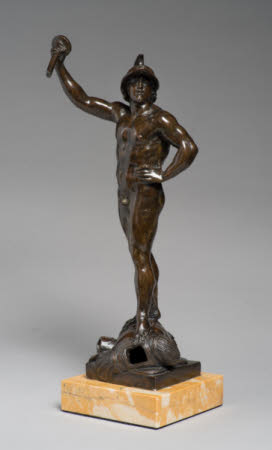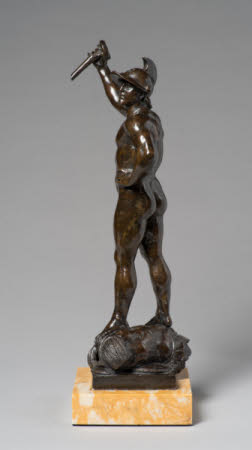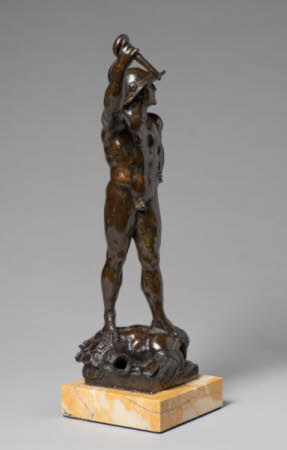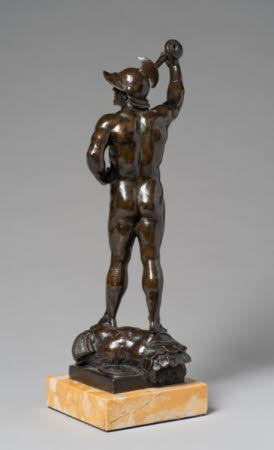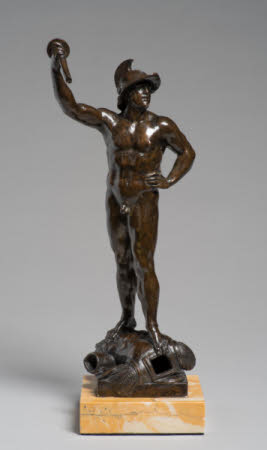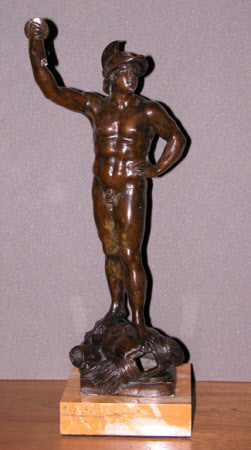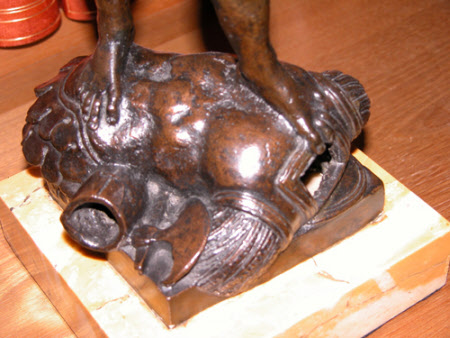Mars
Italian School
Category
Art / Sculpture
Date
circa 1540
Materials
Bronze and Siena marble
Measurements
400 mm (Height)
Order this imageCollection
Anglesey Abbey, Cambridgeshire
NT 515034
Summary
Bronze on Siena marble, Mars, Paduan or Venetian, c. 1540. A sixteenth-century bronze figure of a warrior, made in Padua or in Venice, c. 1540. The warrior, probably a representation of the god of war Mars, is naked except for his helmet. He turns towards his left, holding in his raised right hand the end of a torch, his left hand placed upon his hip. Stands upon a panoply of armour consisting of a cuirass, open at the top and at the right arm, underneath which are a shield, an axe and an unidentified object, perhaps a greave (leg piece). There is a rectangular hole at the front of the helmet, presumably for the fixing of some lost piece. An integral rectangular bronze socle, fixed to a yellow Siena marble base.
Full description
The figure probably represents Mars, the god of War in ancient Rome. It is not easy to understand what the object held in the raised right hand would have been, but it is probably the handle of some form of torch, the main section of which, now lost, would have slotted into a hole in the surface of the circular section. Although Mars is more usually depicted holding a sword, he may be seen with a flaming brand or torch in some series of Northern European prints of the Planetary Gods (see: Monogrammist CG, Netherlandish, c. 1500-50, British Museum example, Inv. PD 1913,0213.4; Heinrich Aldegrever, 1529 and 1533, BM PD 1875,0313.55 and PD E,4.352; School of Lucas Cranach the Younger, 1550-70, BM PD 1904,0519.6; Johannes Wierix, 1579, BM PD 2006,U.579). The torch is evidently symbolic of the destruction that war and conflict bring. The cuirass and armour upon which Mars stands in the bronze resemble a body, as a further allusion to the god as the bringer of death; in the 1529 print by Aldegrever, he steps over a not dissimilar corpse of a male, lying on the ground. The bronze statuette should therefore be read as a representation of Mars, both as the god of war and, perhaps, as the symbol of the planet that bears his name. Seven ‘planets’ were known in the sixteenth century: Mercury, Venus, Mars, Jupiter, Saturn, plus Sol (the sun) and Luna (the moon). Series of representations of the planetary gods became popular, so it is possible that the bronze once formed part of such a series, although no other candidates for the series have been identified. The bronze would seem to be a Paduan or Venetian work, probably made around 1540. The distinctive helmet worn by Mars is a type that was in use in Northern Italy in the period c. 1490-1530. There is a second, all but identical, version of the figure in the Kunsthistorisches Museum, Vienna (Inv. KK 5771. Leo Planiscig, Venezianische Bildhauer der Renaissance, Vienna 1921, p. 571, Abb. 624; Leo Planiscig, Kunsthistorisches Museum Wien: Die Bronzeplastiken, Statuetten, Reliefs, Geräte und Plaketten, Vienna 1924, p. 119, no. 203; Italienische Kleinplastiken, Zeichnungen und Musik der Renaissance, Waffen des 16. und 17. Jahrhunderts, exh. cat., Schloss Schallaburg 1976, p. 92, no. 96). The Vienna figure was first recorded in 1735, when it was published in the compilation of illustrations of paintings and sculptures in the Imperial collections, Francesco de Stampart and Anton Brenner, Prodromus, seu praeambulare lumen reserati portentosae magnificentiae Theatri quo omnia ad aulam Caesaream, Vienna 1735 [Prodromus, oder Vorlicht des Schau- und Wunder-Trachtes aller deren an dem Kaiserl. Hof], Pl. 30. Leo Planiscig associated the figure with the Paduan sculptor Tiziano Aspetti (1557/59-1606), but in cataloguing it for the 1976 Schloss Schallaburg exhibition, Manfred Leithe-Jasper correctly thought that it was earlier in date, having more in common with the bronzes of Aspetti’s uncle Tiziano Minio (1511/12-1552), notably a bronze group of Neptune on his Chariot, known in a number of versions, including one in the Kunsthistorisches Museum (Manfred Leithe-Jasper, Renaissance Master Bronzes from the collection of the Kunsthistorisches Museum Vienna, London 1986, pp. 171-74, no. 43). Perhaps a version of this bronze was known to the British neo-classical sculptor Thomas Banks (1735-1805), since the statuette is very similar in conception, and also reasonably similar in pose, to a larger terracotta figure of Achilles Arming, made by Banks around 1777 in Rome, now in the Victoria & Albert Museum (Inv. A.22:1, 2-1955. C. F. Bell, Annals of Thomas Banks. Sculptor, Royal Academician, Cambridge 1938, p. 193, Pl. XLIII). Banks’s statuette includes a cuirass, in this case placed behind the figure (so as to provide a structural support in a completed marble group) whilst the naked hero places an elaborate helmet upon his head. Jeremy Warren 2019
Provenance
Acquired by Urban Huttleston Rogers Broughton, 1st Lord Fairhaven (1896-1966) after 1940; bequeathed by Lord Fairhaven in 1966 with the house and the rest of the contents.
Credit line
Anglesey Abbey, The Fairhaven Collection (The National Trust)
Makers and roles
Italian School, sculptor
References
Christie, Manson & Woods 1971: The National Trust, Anglesey Abbey, Cambridge. Inventory: Furniture, Textiles, Porcelain, Bronzes, Sculpture and Garden Ornaments’, 1971, p. 137, Silver Strong Room. Prodromus, seu praeambulare lumen reserati portentosae magnificentiae Theatri quo omnia ad aulam Caesaream, [Prodromus, oder Vorlicht des Schau- und Wunder-Trachtes aller deren an dem Kaiserl. Hof], Vienna 1735, pl. 30. Planiscig 1921: Leo Planiscig, Venezianische Bildhauer der Renaissance, Vienna 1921, p. 571, Abb. 624. Planiscig 1924: Leo Planiscig, Kunsthistorisches Museum Wien: Die Bronzeplastiken, Statuetten, Reliefs, Geräte und Plaketten, Vienna 1924, p. 119, no. 203. Italienische Kleinplastiken, Zeichnungen und Musik der Renaissance, Waffen des 16. und 17. Jahrhunderts, exh. cat., Schloss Schallaburg 1976, p. 92, no. 96.
